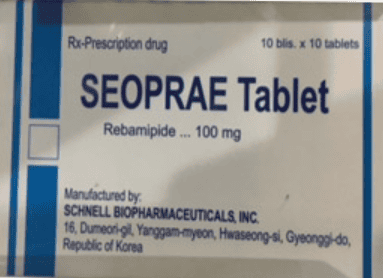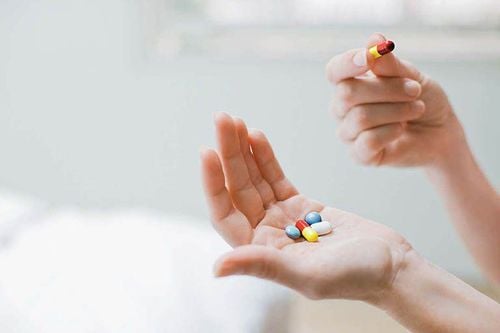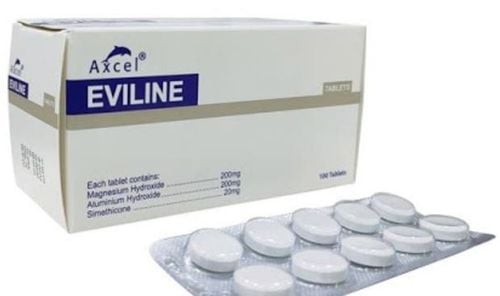This is an automatically translated article.
Sucrahasan is an antacid, anti-reflux and ulcer drug used to treat peptic ulcer disease, gastroesophageal reflux disease or chronic gastritis. Understanding the effects as well as following the correct indications and doses of Sucrahasan will help patients improve treatment effectiveness and prevent unwanted side effects.1. What is Sucrahasan?
Sucrahasan has the main ingredient is Sucralfate 1g, prepared in powder form, packed in a box of 30 packs. Sucralfate is an active ingredient that heals peptic ulcers by the mechanism of complexing with substances such as Albumin and Fibrinogen of exudate to bind the ulcer, thereby forming a barrier to prevent the effect of Pepsin. , bile salts, especially stomach acid. Sucralfate also has a protective effect on the gastric mucosa by increasing the production of prostaglandin E2 and gastric mucus through the mechanism of inhibiting the action of pepsin binding to bile salts. Most of Sucrahasan after oral administration will be excreted in the feces, only a very small amount of Sucralfate in the drug is absorbed by the gastrointestinal tract and excreted by the kidneys. However, a significant proportion of aluminum and disaccharides in Sucrahasan is absorbed into the body after taking a 1g dose of Sucrahasan.
2. Indications and contraindications of Sucrahasan
Sucrahasan is indicated in the following cases:
Gastroesophageal reflux disease (GERD); Gastric - duodenal ulcers, chronic gastritis, benign ulcers; Prevention of stress ulcer, duodenal ulcer recurrence after being treated well. Sucrahasan should not be used in the following cases:
Patients with a history of hypersensitivity to Sucralfate or any of its ingredients.
3. Dosage and how to use Sucrahasan
How to use:
Sucrahasan is used in the form of a powder mixed into an oral suspension for patients 4 years of age and older. The patient mixes 1 sachet of Sucrahasan 1g with half a glass of water into a homogeneous suspension and drinks it all at once. The drug is taken before eating and sleeping. Dosage for each specific case:
Gastroesophageal reflux disease: 1g/x 4 times/day for 4-8 weeks. Do not use more than 12 months. Gastric - duodenal ulcer: Usual dose: 1g/time x 4 times/day or 2g/time x 2 times/day for 4-8 weeks until endoscopy or X-ray image shows that the ulcer has healed completely. . Treatment can be extended by up to 2 weeks if necessary; Sucrahasan is often combined with histamine H2 blockers or Proton pump inhibitors and antibiotics to increase the effectiveness of treatment. Prevention of peptic ulcer recurrence: 1g/time x 2 times/day for up to 6 months. Should be combined with antibiotics to rule out the cause of recurrence due to Helicobacter pylori. Dosage for children over 4 years old: 40-80 mg/kg body weight/day divided into 4 oral doses, using Sucrahasan 1 hour before meals and before bedtime. Some undesirable side effects patients may experience when using Sucrahasan:
Common: Constipation; Uncommon: Nausea, flatulence, dry mouth, dyspepsia, headache, drowsiness, back pain; Uncommon: Urticaria, pruritus, laryngospasm, rhinitis, dizziness, insomnia. When experiencing unwanted effects during treatment with Sucrahasan, patients need to see a doctor for advice on appropriate management.
In the event of a missed dose, the patient does not take the missed dose. There are currently no clinical reports of overdose symptoms when using Sucrahasan. In case of overdose, the patient should consult a doctor or the nearest medical facility.
4. Sucrahasan drug interactions
Sucrahasan drug can interact if used concurrently with the following drugs and substances:
Antacid: Reduces the adhesion of Sucralfate on the gastric mucosa. If used together, should be taken about 1⁄2 hours apart; Cimetidine, Ranitidine, Quinolone antibiotics such as Ciprofloxacin, Norfloxacin, Ofloxacin, cardiovascular drugs such as Digoxin, Warfarin, Tetracycline antibiotics: Using together with Sucrahasan will cause a decrease in absorption. When using Sucralfate and the above drugs, it should be taken at least 2 hours apart to reduce the effect of interaction.; Sucralfate is bound to proteins in food or in certain other drugs, so patients on nasogastric tube feeding should take Sucrahasan separately from food and other drugs.
5. Notes when using Sucrahasan
Use caution in patients with renal impairment because Sucrahasan has a small amount of aluminum that can be absorbed, especially when used concurrently with other aluminum-containing drugs; Not contraindicated but limited to use in pregnant or lactating women; Be careful when driving and operating machinery because Sucrahasan can cause fatigue, decreased alertness, dizziness, lightheadedness; Do not use alcohol, stimulants during treatment with Sucrahasan; Do not use Sucrahasan if the drug has mold, discoloration, watery, expired date. Above is all information about Sucrahasan, patients need to carefully read the instructions, consult a doctor to understand the uses, dosage and notes before using the drug.
Please dial HOTLINE for more information or register for an appointment HERE. Download MyVinmec app to make appointments faster and to manage your bookings easily.













